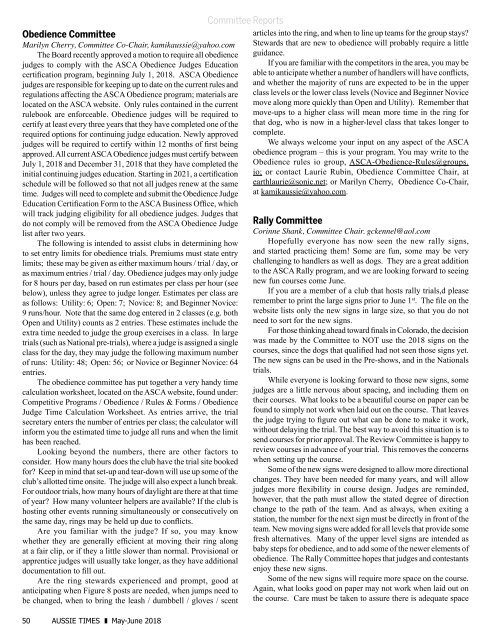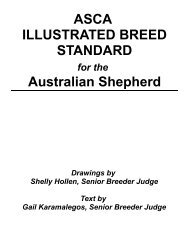2018 May June
You also want an ePaper? Increase the reach of your titles
YUMPU automatically turns print PDFs into web optimized ePapers that Google loves.
Obedience Committee<br />
Marilyn Cherry, Committee Co-Chair, kamikaussie@yahoo.com<br />
The Board recently approved a motion to require all obedience<br />
judges to comply with the ASCA Obedience Judges Education<br />
certification program, beginning July 1, <strong>2018</strong>. ASCA Obedience<br />
judges are responsible for keeping up to date on the current rules and<br />
regulations affecting the ASCA Obedience program; materials are<br />
located on the ASCA website. Only rules contained in the current<br />
rulebook are enforceable. Obedience judges will be required to<br />
certify at least every three years that they have completed one of the<br />
required options for continuing judge education. Newly approved<br />
judges will be required to certify within 12 months of first being<br />
approved. All current ASCA Obedience judges must certify between<br />
July 1, <strong>2018</strong> and December 31, <strong>2018</strong> that they have completed the<br />
initial continuing judges education. Starting in 2021, a certification<br />
schedule will be followed so that not all judges renew at the same<br />
time. Judges will need to complete and submit the Obedience Judge<br />
Education Certification Form to the ASCA Business Office, which<br />
will track judging eligibility for all obedience judges. Judges that<br />
do not comply will be removed from the ASCA Obedience Judge<br />
list after two years.<br />
The following is intended to assist clubs in determining how<br />
to set entry limits for obedience trials. Premiums must state entry<br />
limits; these may be given as either maximum hours / trial / day, or<br />
as maximum entries / trial / day. Obedience judges may only judge<br />
for 8 hours per day, based on run estimates per class per hour (see<br />
below), unless they agree to judge longer. Estimates per class are<br />
as follows: Utility: 6; Open: 7; Novice: 8; and Beginner Novice:<br />
9 runs/hour. Note that the same dog entered in 2 classes (e.g. both<br />
Open and Utility) counts as 2 entries. These estimates include the<br />
extra time needed to judge the group exercises in a class. In large<br />
trials (such as National pre-trials), where a judge is assigned a single<br />
class for the day, they may judge the following maximum number<br />
of runs: Utility: 48; Open: 56; or Novice or Beginner Novice: 64<br />
entries.<br />
The obedience committee has put together a very handy time<br />
calculation worksheet, located on the ASCA website, found under:<br />
Competitive Programs / Obedience / Rules & Forms / Obedience<br />
Judge Time Calculation Worksheet. As entries arrive, the trial<br />
secretary enters the number of entries per class; the calculator will<br />
inform you the estimated time to judge all runs and when the limit<br />
has been reached.<br />
Looking beyond the numbers, there are other factors to<br />
consider. How many hours does the club have the trial site booked<br />
for? Keep in mind that set-up and tear-down will use up some of the<br />
club’s allotted time onsite. The judge will also expect a lunch break.<br />
For outdoor trials, how many hours of daylight are there at that time<br />
of year? How many volunteer helpers are available? If the club is<br />
hosting other events running simultaneously or consecutively on<br />
the same day, rings may be held up due to conflicts.<br />
Are you familiar with the judge? If so, you may know<br />
whether they are generally efficient at moving their ring along<br />
at a fair clip, or if they a little slower than normal. Provisional or<br />
apprentice judges will usually take longer, as they have additional<br />
documentation to fill out.<br />
Are the ring stewards experienced and prompt, good at<br />
anticipating when Figure 8 posts are needed, when jumps need to<br />
be changed, when to bring the leash / dumbbell / gloves / scent<br />
50 AUSSIE TIMES <strong>May</strong>-<strong>June</strong> <strong>2018</strong><br />
Committee Reports<br />
articles into the ring, and when to line up teams for the group stays?<br />
Stewards that are new to obedience will probably require a little<br />
guidance.<br />
If you are familiar with the competitors in the area, you may be<br />
able to anticipate whether a number of handlers will have conflicts,<br />
and whether the majority of runs are expected to be in the upper<br />
class levels or the lower class levels (Novice and Beginner Novice<br />
move along more quickly than Open and Utility). Remember that<br />
move-ups to a higher class will mean more time in the ring for<br />
that dog, who is now in a higher-level class that takes longer to<br />
complete.<br />
We always welcome your input on any aspect of the ASCA<br />
obedience program – this is your program. You may write to the<br />
Obedience rules io group, ASCA-Obedience-Rules@groups.<br />
io; or contact Laurie Rubin, Obedience Committee Chair, at<br />
earthlaurie@sonic.net; or Marilyn Cherry, Obedience Co-Chair,<br />
at kamikaussie@yahoo.com.<br />
Rally Committee<br />
Corinne Shank, Committee Chair. gckennel@aol.com<br />
Hopefully everyone has now seen the new rally signs,<br />
and started practicing them! Some are fun, some may be very<br />
challenging to handlers as well as dogs. They are a great addition<br />
to the ASCA Rally program, and we are looking forward to seeing<br />
new fun courses come <strong>June</strong>.<br />
If you are a member of a club that hosts rally trials,d please<br />
remember to print the large signs prior to <strong>June</strong> 1 st . The file on the<br />
website lists only the new signs in large size, so that you do not<br />
need to sort for the new signs.<br />
For those thinking ahead toward finals in Colorado, the decision<br />
was made by the Committee to NOT use the <strong>2018</strong> signs on the<br />
courses, since the dogs that qualified had not seen those signs yet.<br />
The new signs can be used in the Pre-shows, and in the Nationals<br />
trials.<br />
While everyone is looking forward to those new signs, some<br />
judges are a little nervous about spacing, and including them on<br />
their courses. What looks to be a beautiful course on paper can be<br />
found to simply not work when laid out on the course. That leaves<br />
the judge trying to figure out what can be done to make it work,<br />
without delaying the trial. The best way to avoid this situation is to<br />
send courses for prior approval. The Review Committee is happy to<br />
review courses in advance of your trial. This removes the concerns<br />
when setting up the course.<br />
Some of the new signs were designed to allow more directional<br />
changes. They have been needed for many years, and will allow<br />
judges more flexibility in course design. Judges are reminded,<br />
however, that the path must allow the stated degree of direction<br />
change to the path of the team. And as always, when exiting a<br />
station, the number for the next sign must be directly in front of the<br />
team. New moving signs were added for all levels that provide some<br />
fresh alternatives. Many of the upper level signs are intended as<br />
baby steps for obedience, and to add some of the newer elements of<br />
obedience. The Rally Committee hopes that judges and contestants<br />
enjoy these new signs.<br />
Some of the new signs will require more space on the course.<br />
Again, what looks good on paper may not work when laid out on<br />
the course. Care must be taken to assure there is adequate space



